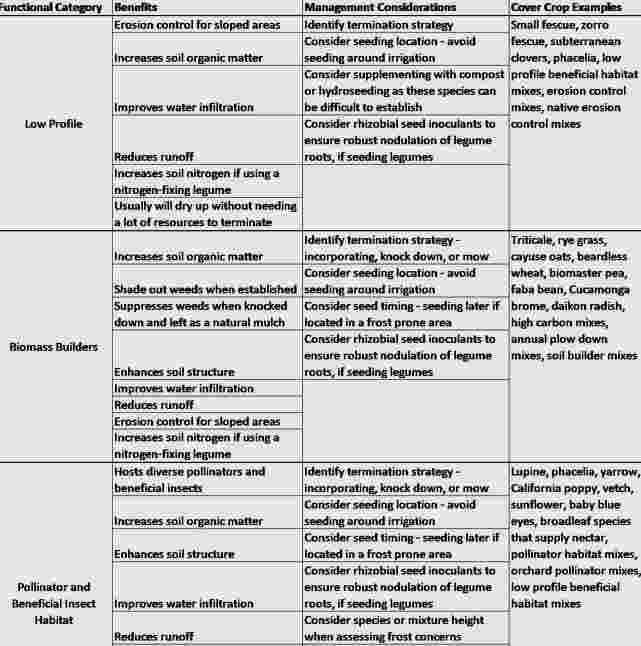Alli Rowe-Fish and Ben Faber
Cover crops offer an important opportunity to build soil health in avocado orchards. A cover crop is a crop seeded or encouraged as natural plant cover as an investment in soil fertility and not as a cash crop. Most cover crops are grasses, legumes, brassicas or a mixture and serve to protect bare soil while improving soil physical, chemical, and biological properties.
Benefits of cover crops
Perennial systems, trees in the ground for long periods of time, are unable to harness the benefits of crop rotation that include improved nutrient cycling, soil tilth, soil physical properties, weed and pest suppression, and erosion control. By cycling cover crops, growers of tree crops can mimic crop rotation on a portion of the land surface and maximize benefits in an orchard system.
The benefits of cover crops in California avocado orchards include:
- Improved soil structure;
- Reduced soil compaction;
- Reduced soil erosion from wind and rain;
- Increased soil organic matter content;
- Improved nutrient cycling;
- Weed suppression;
- Creation of habitat for pollinators and beneficial insects;
- Improved water infiltration
- Improved soil moisture storage
- Increased soil aeration
- Disease suppression.
California will continue to experience increased intensity and duration of drought and heat stress days. These environmental conditions dramatically impact fruit set and viable production of avocados. Improving soil health builds resiliency to climatic conditions and allows farmers to continue to grow in the face of climate change. A specific consideration is improved water infiltration achieved by cover cropping in orchards. The enhancement in soil structure due to the presence of varying depths of roots allows for precipitation to infiltrate rather than run off. By keeping precious precipitation on the orchard property, growers become more resilient in the face of drought and heat. Improved infiltration by rain water can improve salt leaching and reduce salt stress on the tree.
Selecting a cover crop
The main consideration in selecting a cover crop is to identify the purpose and objectives for its use. Table 1 identifies specific goals and considerations for cover cropping. Most avocado growers in California will opt for a winter cover crop to harness winter rains to avoid irrigating. Therefore, the following selections are geared towards winter cover crops and do not go into detail for summer cover cropping.
Cover crop mixes may be more expensive than single species covers such as only a brome or a medic, but satisfy multiple purposes in one planting and often see successful establishment and growth rates. They may provide better cover, weed suppression, and biomass, especially during drought or other non-optimal growing conditions. In addition, mixes supply multiple nutrients and benefits beyond a single species. For example, a mix that includes triticale, faba bean, and daikon radish sees the benefit of soil stabilization and infiltration from all three species, increased carbon content from the triticale, nitrogen fixation from the faba bean, and reduced soil compaction from the radish.
In selecting a cover crop, it is critical to consider any pests that may be encouraged with certain species. For example, many avocado growers are constantly battling gophers in young orchards. Gophers love clover varieties, so if you already have more gophers than you can handle, consider choosing a cover crop mix that does not contain clovers. There does not appear to be an increase of ground squirrel activity with covers (https://digitalcommons.unl.edu/cgi/viewcontent.cgi?article=1020&context=vpc17).
Table 1. Cover Crop Categories and Considerations

Seeding timing
The timing of cover crop seeding will vary based on location and operational goals. However, flexibility is key for getting cover crops seeded at the right time to maximize winter rainfall for good establishment. Many cover crop seed companies will recommend seeding in fall, October or November. In Central and Southern California, that time frame tends to be hot, dry, and windy – not ideal conditions to seed a cover crop. The best time to seed would be right after the first rains come to loosen the soil and provide a bit of moisture. The key to success lies in watching the weather and being able to jump on a window between early rain events.
Frost can be a consideration for many avocado growers in Central and Southern California. Early establishment of tall cover crops can increase risk of frost exposure and should be avoided. To get around frost issues, seeding later in the fall and early winter can delay growth of the cover crop until the frost prone days have passed. This may mean seeding in early January to ensure minimal growth during January and February when frost may be a concern. As the weather warms in March, cover crops can take off and build biomass without posing a risk to tree health.
Termination strategies
Winter cover crops are generally terminated nearing the last rainfall events so they do not compete with trees for irrigation water. Termination strategies vary based on type of cover crop and availability of equipment. Cover crops can be terminated by mowing, tillage/disking, grazing, or simply allowing them to dry up if they are low growing. Leaving cover crop residue on the surface protects the soil from wind erosion, acts as a natural mulch to suppress weed seedlings, and releases nutrients to the soil as it decomposes. The downside to leaving residue on the surface is the retention of moisture which could provide habitat for slugs and snails. Incorporating cover crop residue immediately after termination speeds up the decomposition time, increasing nutrient release into the soil. This should only be considered in young or=chards where root damage would not occur due to incorporation. This, however, requires the right equipment and relatively flat terrain, which is not representative of most California avocado operations. Grazing is an effective termination strategy to remove high biomass cover crops. However, it is important to consider GAP and NOP food safety regulations by ensuring animals are not in the orchard within 90 days of harvest.
Triticale and Lamb Hass
Source : ucanr.edu